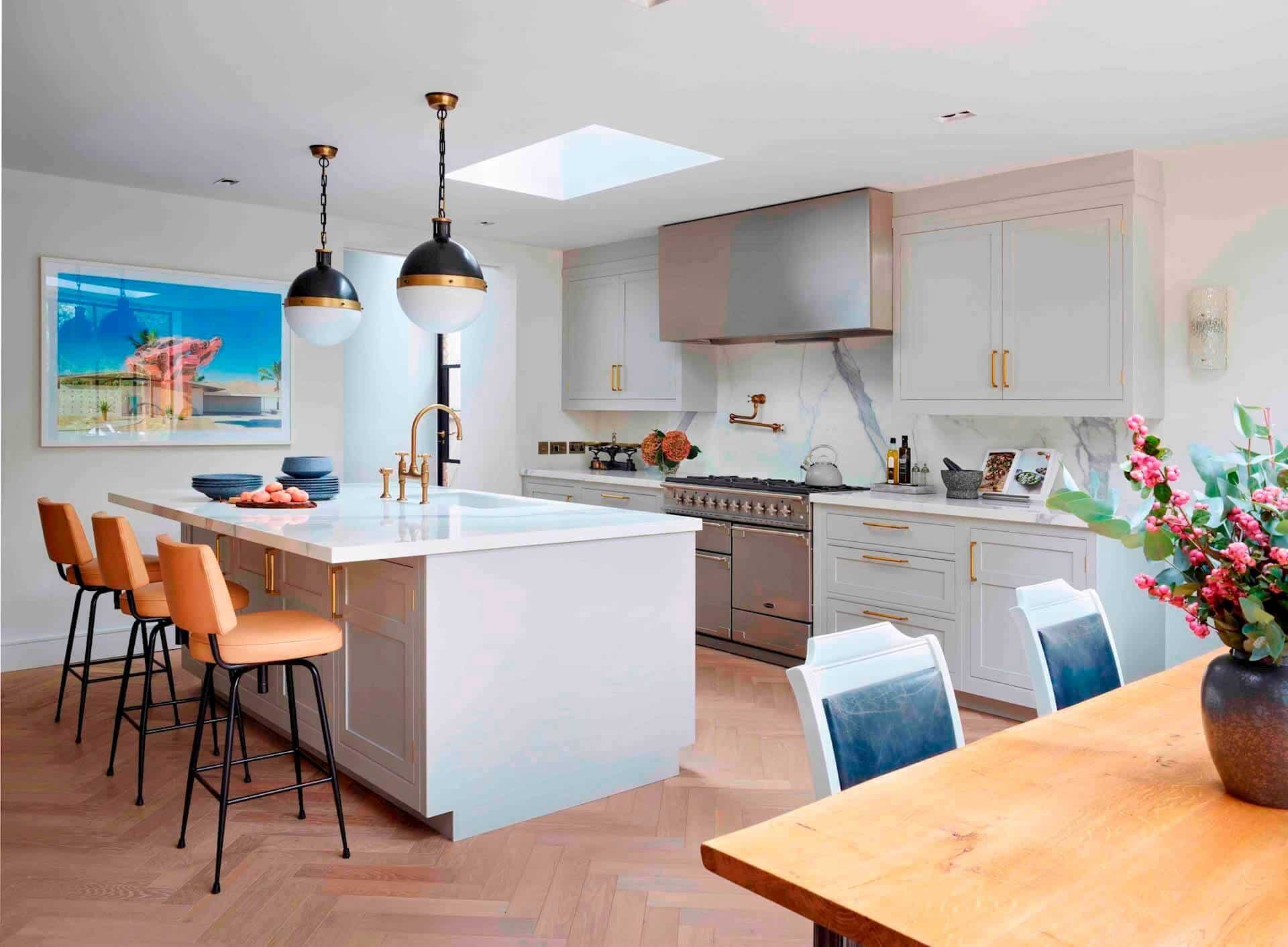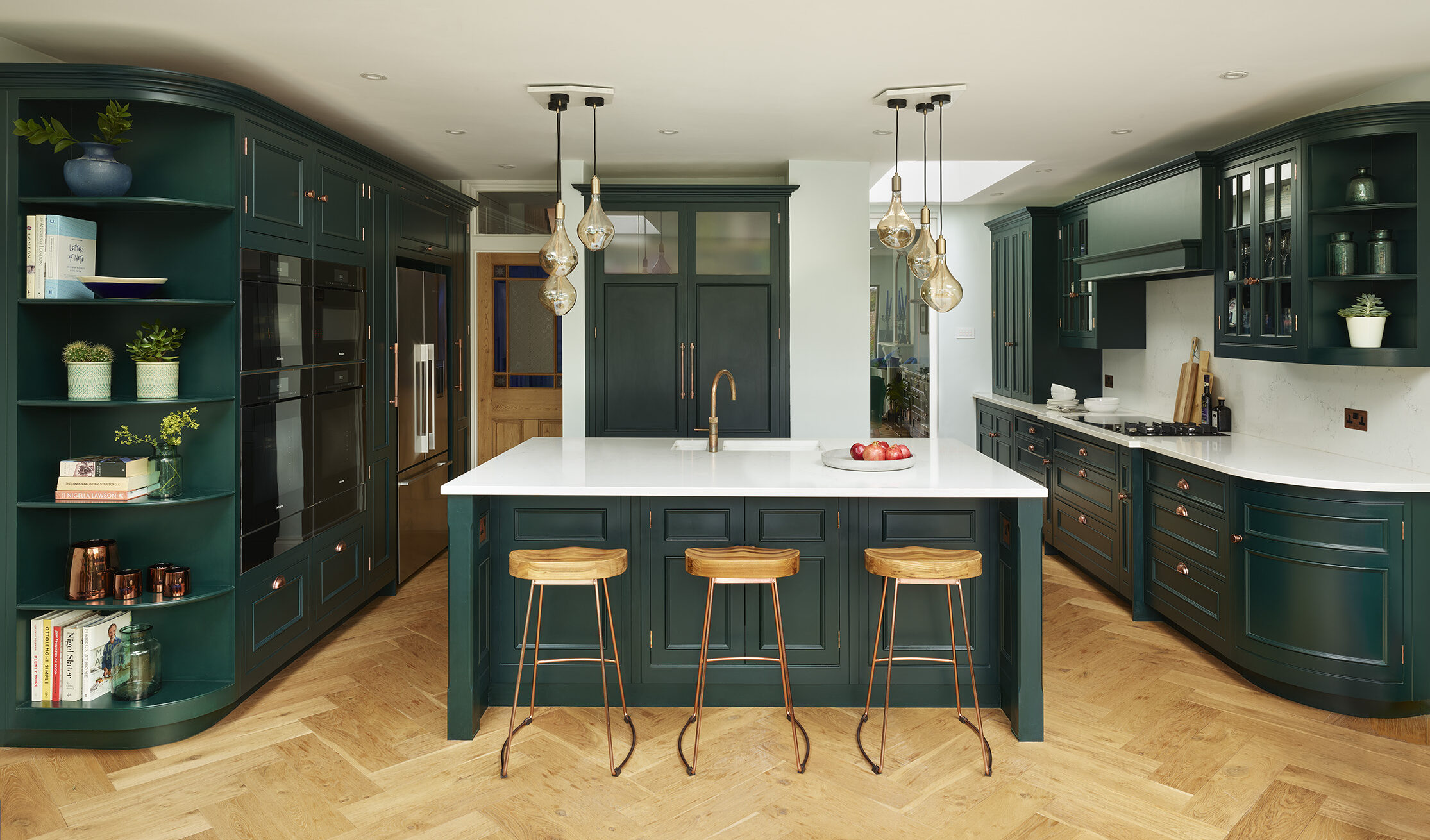
Parquet flooring originated in the late 1600s in Versailles, France, and was once the province of wealthy families and public buildings due to the skill and time required to install it. A few of the earliest instances still exist and are considered works of art in their own right, such as the Galerie d’Hercule at the Hôtel Lambert in Paris.
Created from small blocks of wood that are laid in a pattern, it is increasingly popular for homeowners to opt for parquet flooring in the kitchen thanks to its artistic beauty and natural warmth — but is it a suitable choice? Here we’re going to consider whether parquet floors make sense for kitchens and the best types to go for.
5 Factors to Consider When Choosing Parquet Flooring in Kitchens
1. Aesthetics
Wooden parquet flooring has a certain warmth and grandeur that, try as you might, you simply cannot achieve with other materials. A stylish juxtaposition between old and new, parquet allows you to choose from multiple available tones, materials, and patterns. The choices are endless: from the subtle ‘herringbone’ with light-reflecting qualities, to the stunning, mosaic-like ‘Versailles’ flooring. Be sure to take a look at our Victorian Kitchen design with a parquet arrangement of wooden flooring to see how this style can look in practice.
However, though it can add great character to small kitchens, parquet flooring may be most suited to a more spacious room. It’s made to be seen — not covered by utilities and work surfaces.
2. Appliances
Your kitchen likely contains several large appliances, including your washing machine and dishwasher, and therefore your floor could be at risk of water damage. While this is unlikely unless an appliance has been poorly installed, it’s a good idea to be aware of the potential risk — water is the ‘Achilles heel’ of parquet flooring. You probably wouldn’t opt for a hardwood floor in the bathroom because of the inevitable water damage, so ask yourself — is your kitchen any different?
It is definitely achievable to maintain a well kept parquet floor, but you must habitually (and immediately) mop up any spillages to avoid warping and other long-term damage. You should also be aware of other appliances, such as your oven — your beautiful wooden tiles could potentially shrink and buckle if exposed long-term to heat and humidity. If water damage is a concern, there are other alternatives to using wood available that will still achieve the look and feel of parquet flooring, for example this bold Shaker Kitchen uses porcelain wood effect tiles.
3. Lifestyle
The kitchen is often alive with a warm buzz of activity, and parquet flooring is not designed for constant wear and tear. So, consider your lifestyle and what may happen if you host there frequently. A gathering of killer heels could easily prove to be, well, killer to your beautiful flooring.
Also, think about your pets — could they mistake it as a scratching post if they have regular access to the kitchen? Speaking of access, muddy paws or dripping wet trainers will impact the floor’s longevity, especially if your kitchen is located by the garden door.
4. Maintenance
A hardwood floor is a luxury splurge that should be treated with due care. It will need regular cleaning with an appropriate wooden floor cleaner — never bleach. Harsh cleaners can strip the floor of its pigment, as will lots of direct sunlight. You can hoover parquet flooring, but investing in an attachment with soft bristles is important to avoid accidental scratches. Better yet, leave all shoes at the door.
As time goes on, don’t panic if you notice some mild wear and tear, however — solid parquet is designed to be sanded down and re-varnished every few years.
5. Investment
Wooden flooring can be a charming but costly investment — as you can imagine, quality parquet is not always budget-friendly and finishing services can add to the cost. For example, the aged or ‘distressed’ finish is a popular choice, but can be more expensive due to the finishing process.
However, a hardwood parquet floor (if well-cared for) will last for many generations, so may be a worthwhile long term investment despite the significant upfront expenditure.
What is the Best Type of Parquet Flooring for Kitchens?
Solid Wood
The original (and arguably the best) type of parquet flooring offers many solid advantages, the first and foremost one being its natural beauty. A solid hardwood floor can transform a humble kitchen into a stunning focal point of the house. Opting for solid wood, you can choose from numerous grains, shades, and finishes to fit your aesthetic. For a long-lasting kitchen floor, consider oak, cherry or maple varieties instead of the softer cedar or redwood.
Engineered Wood
Engineered parquet is a lower-cost alternative to solid wood, typically comprising multiple layers of plywood with a solid hardwood layer on top. This type of flooring can make a fantastic alternative to traditional parquet as it has the same ambience and unmistakable natural look. Significantly, its layers offer good stability and are less prone to warping or shrinkage than solid wood. This is a perfect choice if you are eyeing up underfloor heating or are concerned about the damage of heat from kitchen appliances.
However, it’s not indestructible and will wear quicker than solid hardwood, which can last for decades.
Reclaimed Wood
If you’re looking to add a rustic edge or a little cottagecore to your kitchen, then reclaimed wooden flooring might be for you. This type of flooring is a more environmentally-friendly option, as no further deforestation is required to source repurposed wood. On the other hand, it can be on the more expensive side, even if you opt for engineered wooden beams, due to the distressing and finishing processes involved. It’s not a new concept, but thanks to growing demand for eco-friendly remodelling options, reclaimed wood has recently enjoyed a surge in popularity.
So, is parquet flooring in kitchens a suitable choice? The final decision is up to you, but we hope that this guide has given you all the information you need to make the choice. If you’d like some professional advice from our team of expert kitchen designers, please don’t hesitate to contact us on 0800 389 6938 or use our handy showroom locator.





